LSST BA3LC91O Report: Little Dessert Shop Business Analysis
VerifiedAdded on 2023/01/04
|9
|1922
|80
Report
AI Summary
This report analyzes the business of Little Dessert Shop, a joint venture in Birmingham providing organic food products. It examines the partnership structure, specifically a general partnership between Mary and Sue, detailing its advantages and disadvantages. The report applies Porter's Five Forces to assess the competitive environment, considering the threat of new entrants, supplier power, buyer power, threat of substitutes, and rivalry among competitors. Furthermore, it utilizes PESTLE analysis to evaluate the macro-environmental factors impacting the business, including political, economic, social, and technological influences. The report concludes by summarizing key findings and emphasizing the importance of strategic planning in the food industry, particularly in response to changing consumer preferences and market dynamics. It also highlights the impact of the COVID-19 pandemic and Brexit on the business operations.

Introduction to business
Paraphrase This Document
Need a fresh take? Get an instant paraphrase of this document with our AI Paraphraser
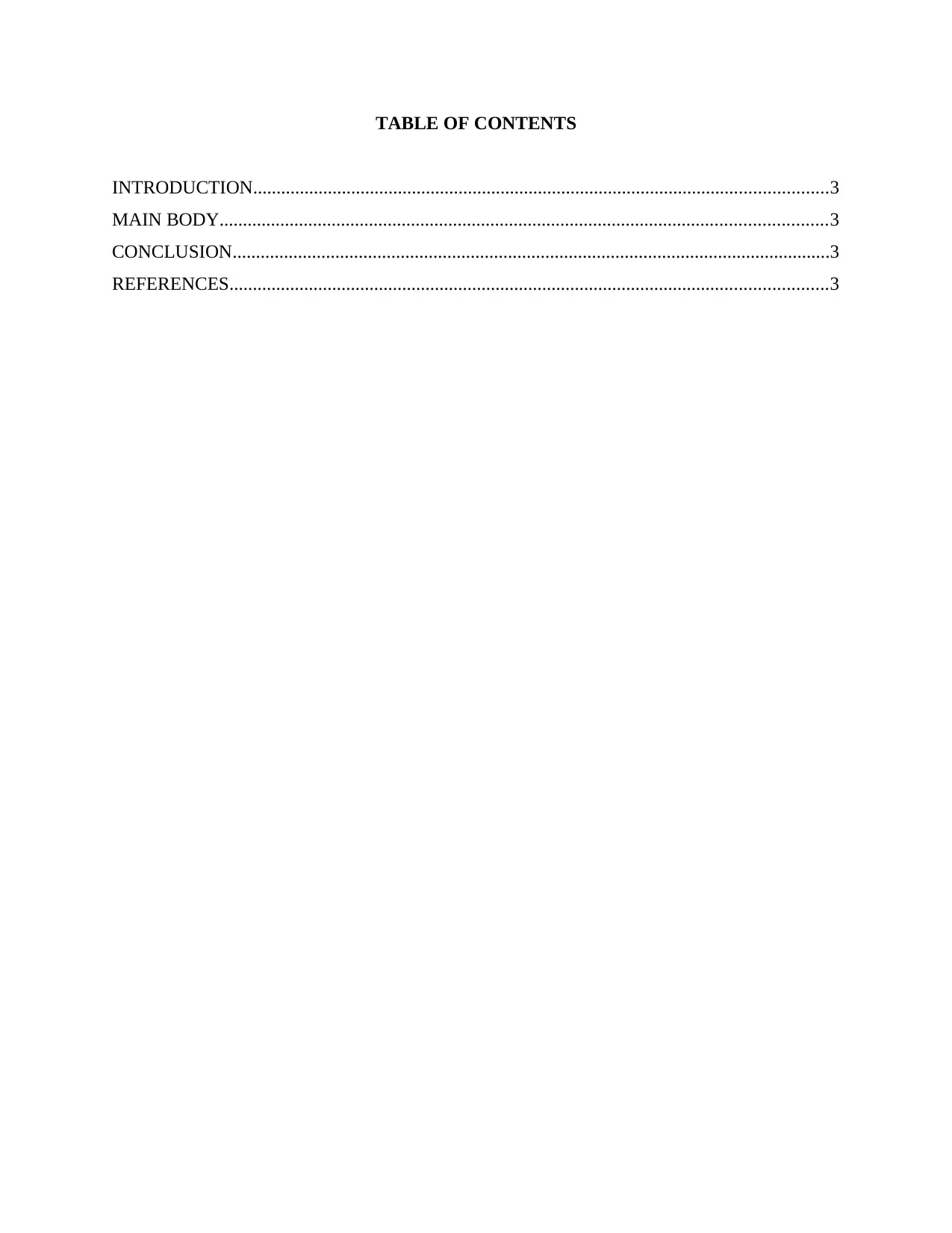
TABLE OF CONTENTS
INTRODUCTION...........................................................................................................................3
MAIN BODY..................................................................................................................................3
CONCLUSION................................................................................................................................3
REFERENCES................................................................................................................................3
INTRODUCTION...........................................................................................................................3
MAIN BODY..................................................................................................................................3
CONCLUSION................................................................................................................................3
REFERENCES................................................................................................................................3
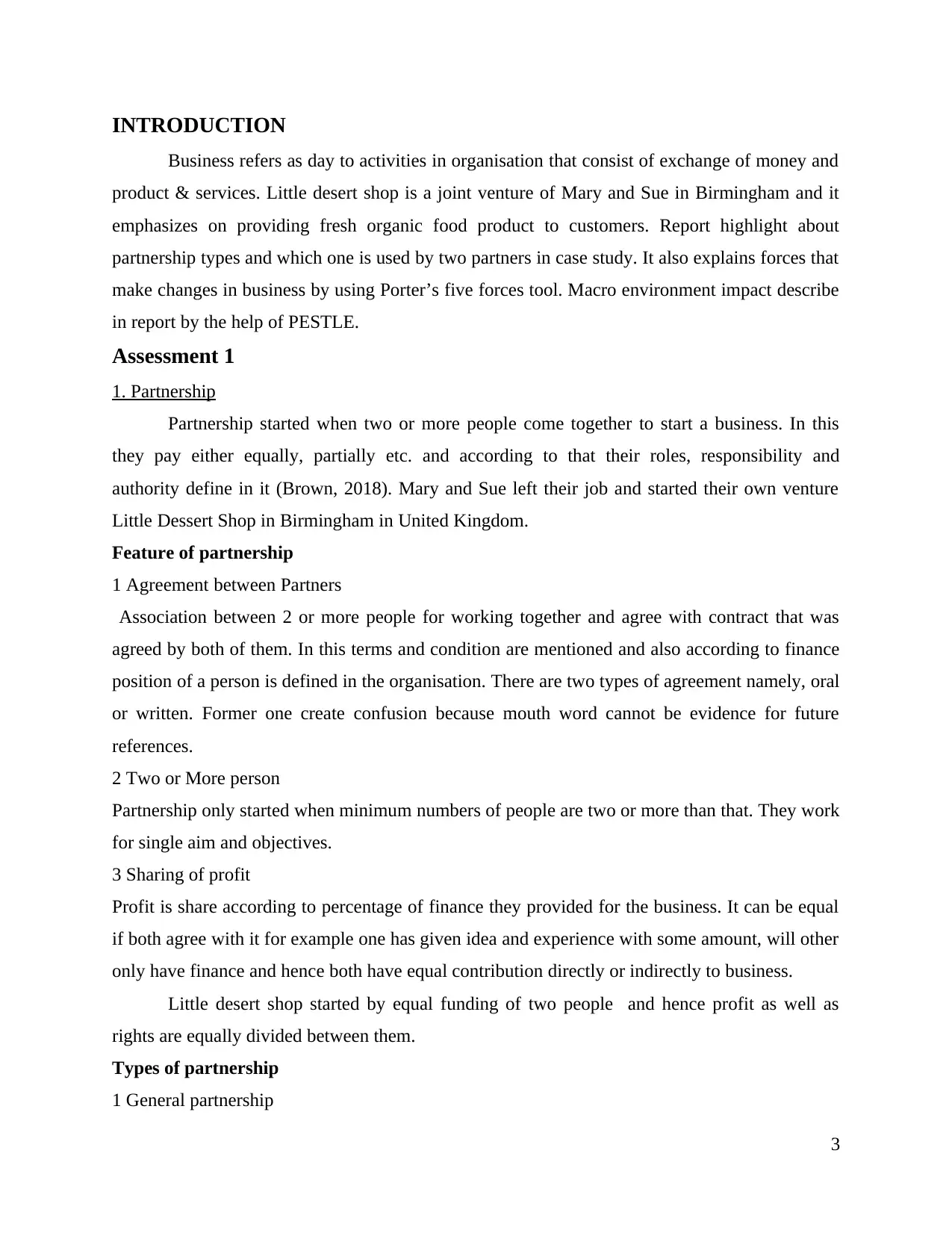
INTRODUCTION
Business refers as day to activities in organisation that consist of exchange of money and
product & services. Little desert shop is a joint venture of Mary and Sue in Birmingham and it
emphasizes on providing fresh organic food product to customers. Report highlight about
partnership types and which one is used by two partners in case study. It also explains forces that
make changes in business by using Porter’s five forces tool. Macro environment impact describe
in report by the help of PESTLE.
Assessment 1
1. Partnership
Partnership started when two or more people come together to start a business. In this
they pay either equally, partially etc. and according to that their roles, responsibility and
authority define in it (Brown, 2018). Mary and Sue left their job and started their own venture
Little Dessert Shop in Birmingham in United Kingdom.
Feature of partnership
1 Agreement between Partners
Association between 2 or more people for working together and agree with contract that was
agreed by both of them. In this terms and condition are mentioned and also according to finance
position of a person is defined in the organisation. There are two types of agreement namely, oral
or written. Former one create confusion because mouth word cannot be evidence for future
references.
2 Two or More person
Partnership only started when minimum numbers of people are two or more than that. They work
for single aim and objectives.
3 Sharing of profit
Profit is share according to percentage of finance they provided for the business. It can be equal
if both agree with it for example one has given idea and experience with some amount, will other
only have finance and hence both have equal contribution directly or indirectly to business.
Little desert shop started by equal funding of two people and hence profit as well as
rights are equally divided between them.
Types of partnership
1 General partnership
3
Business refers as day to activities in organisation that consist of exchange of money and
product & services. Little desert shop is a joint venture of Mary and Sue in Birmingham and it
emphasizes on providing fresh organic food product to customers. Report highlight about
partnership types and which one is used by two partners in case study. It also explains forces that
make changes in business by using Porter’s five forces tool. Macro environment impact describe
in report by the help of PESTLE.
Assessment 1
1. Partnership
Partnership started when two or more people come together to start a business. In this
they pay either equally, partially etc. and according to that their roles, responsibility and
authority define in it (Brown, 2018). Mary and Sue left their job and started their own venture
Little Dessert Shop in Birmingham in United Kingdom.
Feature of partnership
1 Agreement between Partners
Association between 2 or more people for working together and agree with contract that was
agreed by both of them. In this terms and condition are mentioned and also according to finance
position of a person is defined in the organisation. There are two types of agreement namely, oral
or written. Former one create confusion because mouth word cannot be evidence for future
references.
2 Two or More person
Partnership only started when minimum numbers of people are two or more than that. They work
for single aim and objectives.
3 Sharing of profit
Profit is share according to percentage of finance they provided for the business. It can be equal
if both agree with it for example one has given idea and experience with some amount, will other
only have finance and hence both have equal contribution directly or indirectly to business.
Little desert shop started by equal funding of two people and hence profit as well as
rights are equally divided between them.
Types of partnership
1 General partnership
3
⊘ This is a preview!⊘
Do you want full access?
Subscribe today to unlock all pages.

Trusted by 1+ million students worldwide
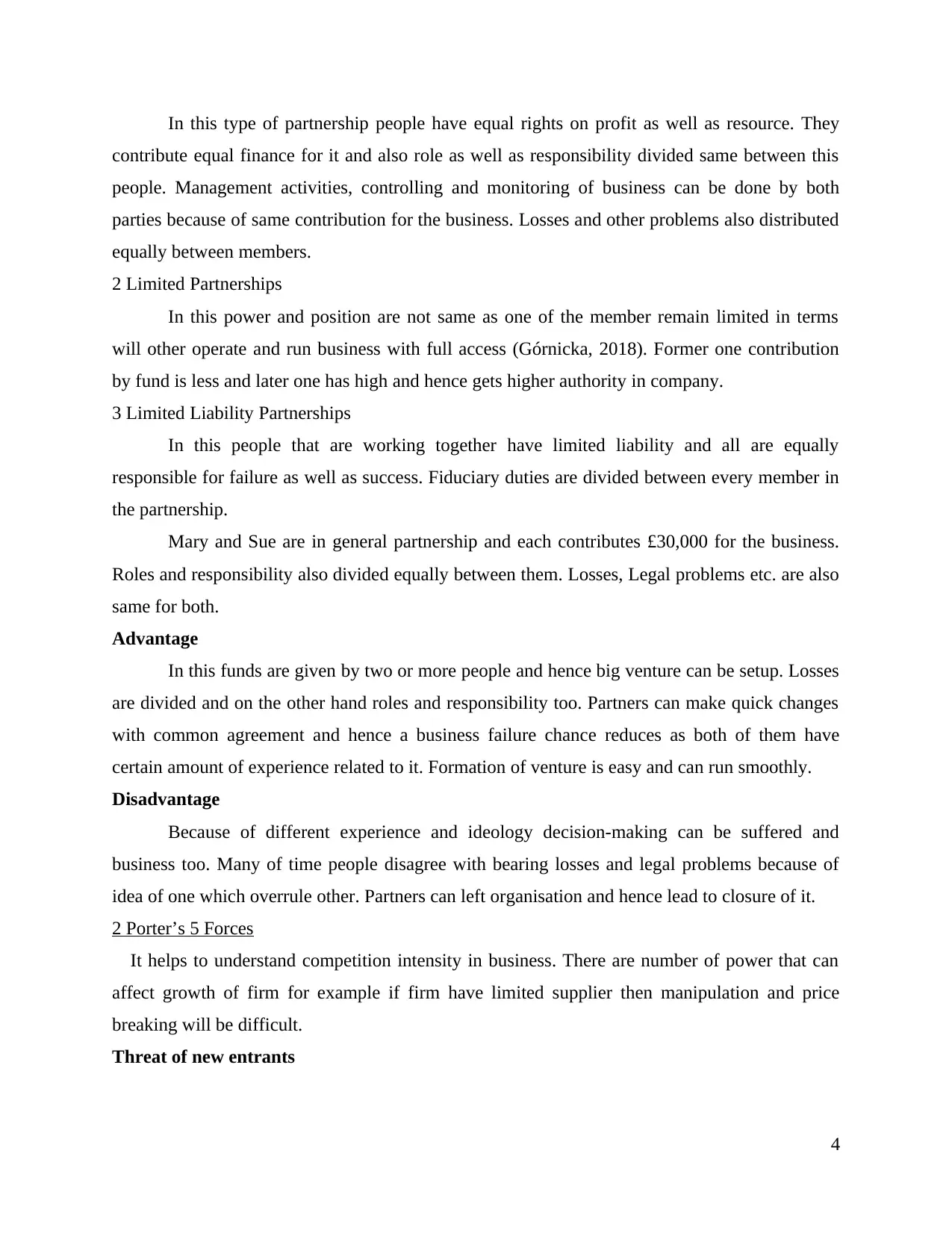
In this type of partnership people have equal rights on profit as well as resource. They
contribute equal finance for it and also role as well as responsibility divided same between this
people. Management activities, controlling and monitoring of business can be done by both
parties because of same contribution for the business. Losses and other problems also distributed
equally between members.
2 Limited Partnerships
In this power and position are not same as one of the member remain limited in terms
will other operate and run business with full access (Górnicka, 2018). Former one contribution
by fund is less and later one has high and hence gets higher authority in company.
3 Limited Liability Partnerships
In this people that are working together have limited liability and all are equally
responsible for failure as well as success. Fiduciary duties are divided between every member in
the partnership.
Mary and Sue are in general partnership and each contributes £30,000 for the business.
Roles and responsibility also divided equally between them. Losses, Legal problems etc. are also
same for both.
Advantage
In this funds are given by two or more people and hence big venture can be setup. Losses
are divided and on the other hand roles and responsibility too. Partners can make quick changes
with common agreement and hence a business failure chance reduces as both of them have
certain amount of experience related to it. Formation of venture is easy and can run smoothly.
Disadvantage
Because of different experience and ideology decision-making can be suffered and
business too. Many of time people disagree with bearing losses and legal problems because of
idea of one which overrule other. Partners can left organisation and hence lead to closure of it.
2 Porter’s 5 Forces
It helps to understand competition intensity in business. There are number of power that can
affect growth of firm for example if firm have limited supplier then manipulation and price
breaking will be difficult.
Threat of new entrants
4
contribute equal finance for it and also role as well as responsibility divided same between this
people. Management activities, controlling and monitoring of business can be done by both
parties because of same contribution for the business. Losses and other problems also distributed
equally between members.
2 Limited Partnerships
In this power and position are not same as one of the member remain limited in terms
will other operate and run business with full access (Górnicka, 2018). Former one contribution
by fund is less and later one has high and hence gets higher authority in company.
3 Limited Liability Partnerships
In this people that are working together have limited liability and all are equally
responsible for failure as well as success. Fiduciary duties are divided between every member in
the partnership.
Mary and Sue are in general partnership and each contributes £30,000 for the business.
Roles and responsibility also divided equally between them. Losses, Legal problems etc. are also
same for both.
Advantage
In this funds are given by two or more people and hence big venture can be setup. Losses
are divided and on the other hand roles and responsibility too. Partners can make quick changes
with common agreement and hence a business failure chance reduces as both of them have
certain amount of experience related to it. Formation of venture is easy and can run smoothly.
Disadvantage
Because of different experience and ideology decision-making can be suffered and
business too. Many of time people disagree with bearing losses and legal problems because of
idea of one which overrule other. Partners can left organisation and hence lead to closure of it.
2 Porter’s 5 Forces
It helps to understand competition intensity in business. There are number of power that can
affect growth of firm for example if firm have limited supplier then manipulation and price
breaking will be difficult.
Threat of new entrants
4
Paraphrase This Document
Need a fresh take? Get an instant paraphrase of this document with our AI Paraphraser
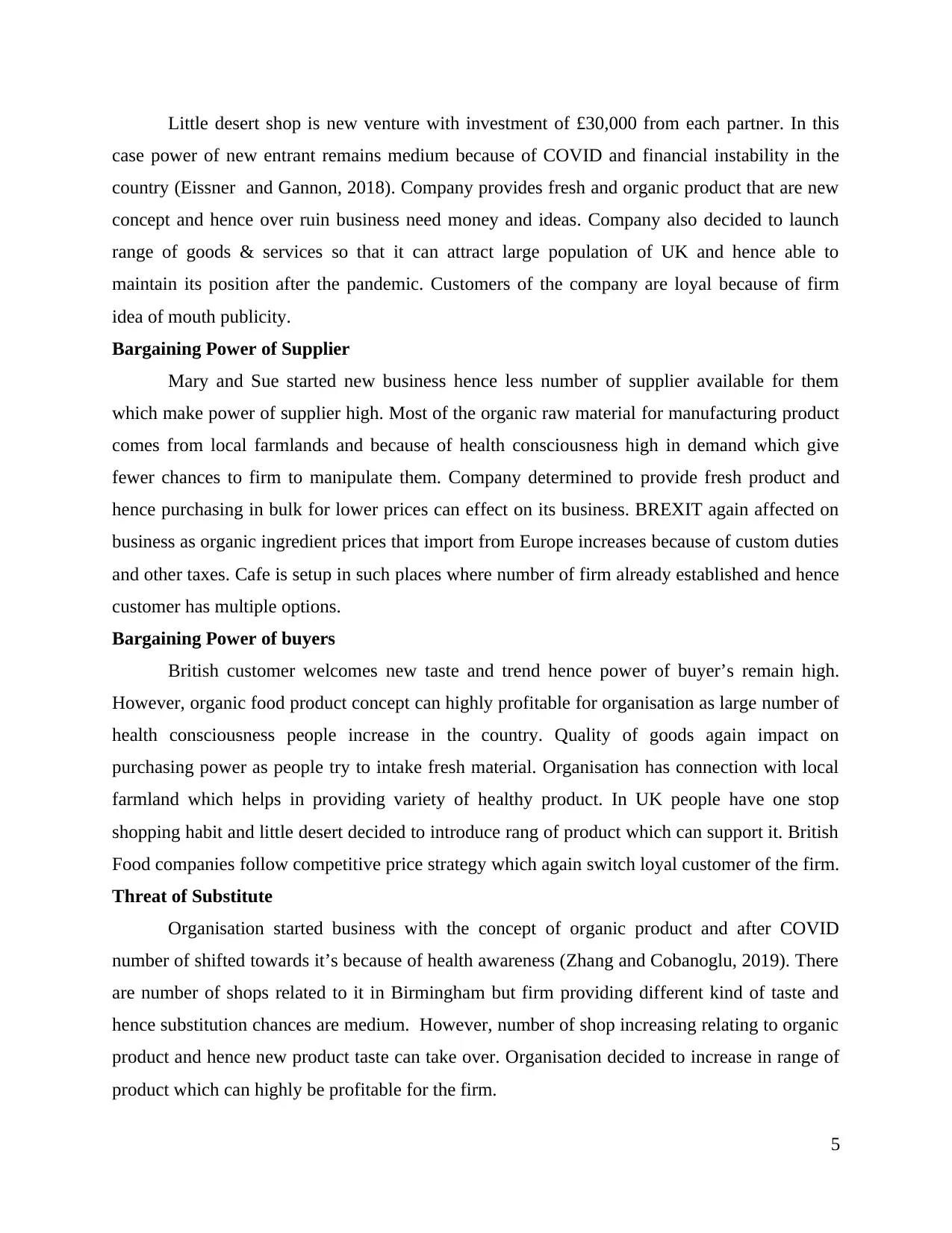
Little desert shop is new venture with investment of £30,000 from each partner. In this
case power of new entrant remains medium because of COVID and financial instability in the
country (Eissner and Gannon, 2018). Company provides fresh and organic product that are new
concept and hence over ruin business need money and ideas. Company also decided to launch
range of goods & services so that it can attract large population of UK and hence able to
maintain its position after the pandemic. Customers of the company are loyal because of firm
idea of mouth publicity.
Bargaining Power of Supplier
Mary and Sue started new business hence less number of supplier available for them
which make power of supplier high. Most of the organic raw material for manufacturing product
comes from local farmlands and because of health consciousness high in demand which give
fewer chances to firm to manipulate them. Company determined to provide fresh product and
hence purchasing in bulk for lower prices can effect on its business. BREXIT again affected on
business as organic ingredient prices that import from Europe increases because of custom duties
and other taxes. Cafe is setup in such places where number of firm already established and hence
customer has multiple options.
Bargaining Power of buyers
British customer welcomes new taste and trend hence power of buyer’s remain high.
However, organic food product concept can highly profitable for organisation as large number of
health consciousness people increase in the country. Quality of goods again impact on
purchasing power as people try to intake fresh material. Organisation has connection with local
farmland which helps in providing variety of healthy product. In UK people have one stop
shopping habit and little desert decided to introduce rang of product which can support it. British
Food companies follow competitive price strategy which again switch loyal customer of the firm.
Threat of Substitute
Organisation started business with the concept of organic product and after COVID
number of shifted towards it’s because of health awareness (Zhang and Cobanoglu, 2019). There
are number of shops related to it in Birmingham but firm providing different kind of taste and
hence substitution chances are medium. However, number of shop increasing relating to organic
product and hence new product taste can take over. Organisation decided to increase in range of
product which can highly be profitable for the firm.
5
case power of new entrant remains medium because of COVID and financial instability in the
country (Eissner and Gannon, 2018). Company provides fresh and organic product that are new
concept and hence over ruin business need money and ideas. Company also decided to launch
range of goods & services so that it can attract large population of UK and hence able to
maintain its position after the pandemic. Customers of the company are loyal because of firm
idea of mouth publicity.
Bargaining Power of Supplier
Mary and Sue started new business hence less number of supplier available for them
which make power of supplier high. Most of the organic raw material for manufacturing product
comes from local farmlands and because of health consciousness high in demand which give
fewer chances to firm to manipulate them. Company determined to provide fresh product and
hence purchasing in bulk for lower prices can effect on its business. BREXIT again affected on
business as organic ingredient prices that import from Europe increases because of custom duties
and other taxes. Cafe is setup in such places where number of firm already established and hence
customer has multiple options.
Bargaining Power of buyers
British customer welcomes new taste and trend hence power of buyer’s remain high.
However, organic food product concept can highly profitable for organisation as large number of
health consciousness people increase in the country. Quality of goods again impact on
purchasing power as people try to intake fresh material. Organisation has connection with local
farmland which helps in providing variety of healthy product. In UK people have one stop
shopping habit and little desert decided to introduce rang of product which can support it. British
Food companies follow competitive price strategy which again switch loyal customer of the firm.
Threat of Substitute
Organisation started business with the concept of organic product and after COVID
number of shifted towards it’s because of health awareness (Zhang and Cobanoglu, 2019). There
are number of shops related to it in Birmingham but firm providing different kind of taste and
hence substitution chances are medium. However, number of shop increasing relating to organic
product and hence new product taste can take over. Organisation decided to increase in range of
product which can highly be profitable for the firm.
5
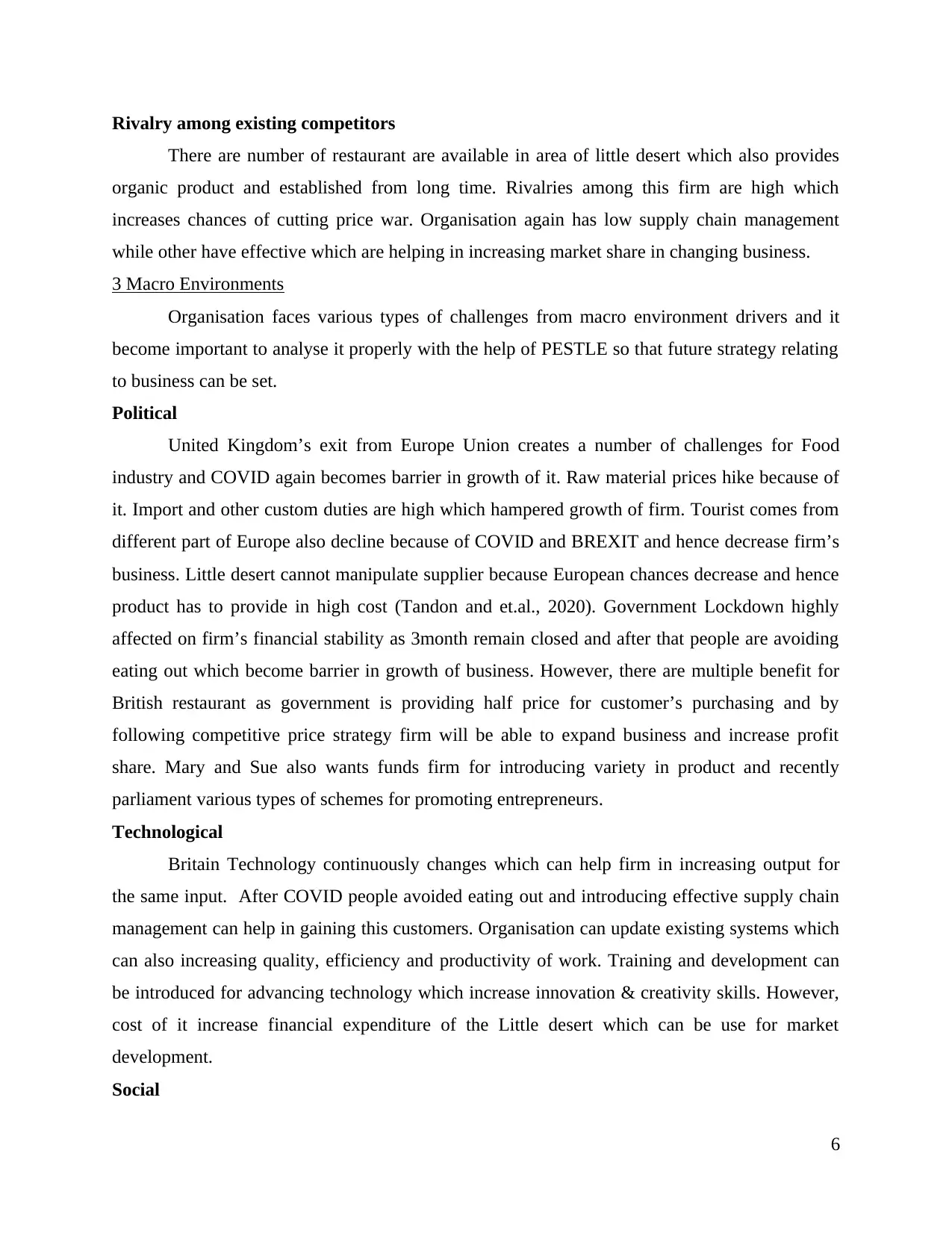
Rivalry among existing competitors
There are number of restaurant are available in area of little desert which also provides
organic product and established from long time. Rivalries among this firm are high which
increases chances of cutting price war. Organisation again has low supply chain management
while other have effective which are helping in increasing market share in changing business.
3 Macro Environments
Organisation faces various types of challenges from macro environment drivers and it
become important to analyse it properly with the help of PESTLE so that future strategy relating
to business can be set.
Political
United Kingdom’s exit from Europe Union creates a number of challenges for Food
industry and COVID again becomes barrier in growth of it. Raw material prices hike because of
it. Import and other custom duties are high which hampered growth of firm. Tourist comes from
different part of Europe also decline because of COVID and BREXIT and hence decrease firm’s
business. Little desert cannot manipulate supplier because European chances decrease and hence
product has to provide in high cost (Tandon and et.al., 2020). Government Lockdown highly
affected on firm’s financial stability as 3month remain closed and after that people are avoiding
eating out which become barrier in growth of business. However, there are multiple benefit for
British restaurant as government is providing half price for customer’s purchasing and by
following competitive price strategy firm will be able to expand business and increase profit
share. Mary and Sue also wants funds firm for introducing variety in product and recently
parliament various types of schemes for promoting entrepreneurs.
Technological
Britain Technology continuously changes which can help firm in increasing output for
the same input. After COVID people avoided eating out and introducing effective supply chain
management can help in gaining this customers. Organisation can update existing systems which
can also increasing quality, efficiency and productivity of work. Training and development can
be introduced for advancing technology which increase innovation & creativity skills. However,
cost of it increase financial expenditure of the Little desert which can be use for market
development.
Social
6
There are number of restaurant are available in area of little desert which also provides
organic product and established from long time. Rivalries among this firm are high which
increases chances of cutting price war. Organisation again has low supply chain management
while other have effective which are helping in increasing market share in changing business.
3 Macro Environments
Organisation faces various types of challenges from macro environment drivers and it
become important to analyse it properly with the help of PESTLE so that future strategy relating
to business can be set.
Political
United Kingdom’s exit from Europe Union creates a number of challenges for Food
industry and COVID again becomes barrier in growth of it. Raw material prices hike because of
it. Import and other custom duties are high which hampered growth of firm. Tourist comes from
different part of Europe also decline because of COVID and BREXIT and hence decrease firm’s
business. Little desert cannot manipulate supplier because European chances decrease and hence
product has to provide in high cost (Tandon and et.al., 2020). Government Lockdown highly
affected on firm’s financial stability as 3month remain closed and after that people are avoiding
eating out which become barrier in growth of business. However, there are multiple benefit for
British restaurant as government is providing half price for customer’s purchasing and by
following competitive price strategy firm will be able to expand business and increase profit
share. Mary and Sue also wants funds firm for introducing variety in product and recently
parliament various types of schemes for promoting entrepreneurs.
Technological
Britain Technology continuously changes which can help firm in increasing output for
the same input. After COVID people avoided eating out and introducing effective supply chain
management can help in gaining this customers. Organisation can update existing systems which
can also increasing quality, efficiency and productivity of work. Training and development can
be introduced for advancing technology which increase innovation & creativity skills. However,
cost of it increase financial expenditure of the Little desert which can be use for market
development.
Social
6
⊘ This is a preview!⊘
Do you want full access?
Subscribe today to unlock all pages.

Trusted by 1+ million students worldwide
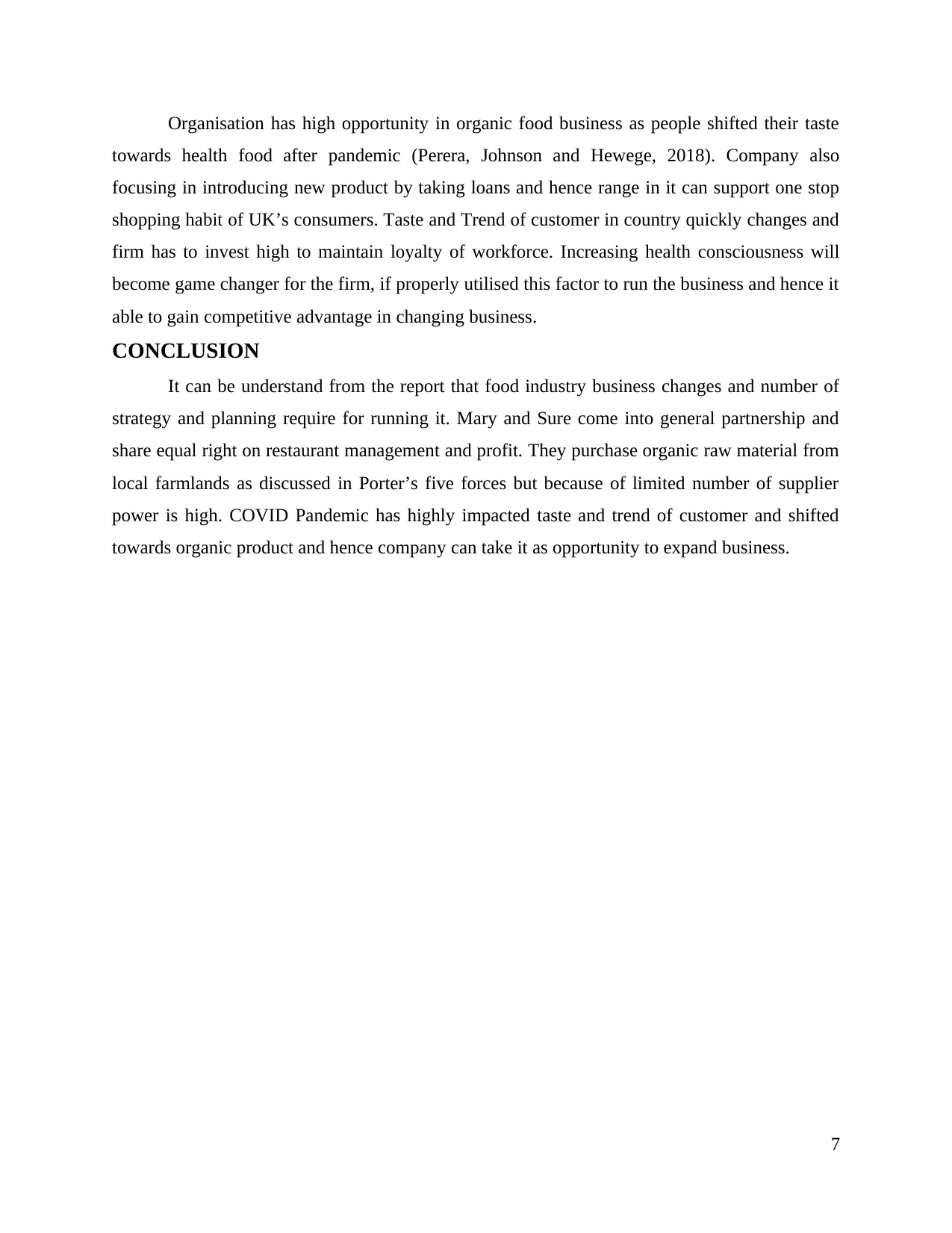
Organisation has high opportunity in organic food business as people shifted their taste
towards health food after pandemic (Perera, Johnson and Hewege, 2018). Company also
focusing in introducing new product by taking loans and hence range in it can support one stop
shopping habit of UK’s consumers. Taste and Trend of customer in country quickly changes and
firm has to invest high to maintain loyalty of workforce. Increasing health consciousness will
become game changer for the firm, if properly utilised this factor to run the business and hence it
able to gain competitive advantage in changing business.
CONCLUSION
It can be understand from the report that food industry business changes and number of
strategy and planning require for running it. Mary and Sure come into general partnership and
share equal right on restaurant management and profit. They purchase organic raw material from
local farmlands as discussed in Porter’s five forces but because of limited number of supplier
power is high. COVID Pandemic has highly impacted taste and trend of customer and shifted
towards organic product and hence company can take it as opportunity to expand business.
7
towards health food after pandemic (Perera, Johnson and Hewege, 2018). Company also
focusing in introducing new product by taking loans and hence range in it can support one stop
shopping habit of UK’s consumers. Taste and Trend of customer in country quickly changes and
firm has to invest high to maintain loyalty of workforce. Increasing health consciousness will
become game changer for the firm, if properly utilised this factor to run the business and hence it
able to gain competitive advantage in changing business.
CONCLUSION
It can be understand from the report that food industry business changes and number of
strategy and planning require for running it. Mary and Sure come into general partnership and
share equal right on restaurant management and profit. They purchase organic raw material from
local farmlands as discussed in Porter’s five forces but because of limited number of supplier
power is high. COVID Pandemic has highly impacted taste and trend of customer and shifted
towards organic product and hence company can take it as opportunity to expand business.
7
Paraphrase This Document
Need a fresh take? Get an instant paraphrase of this document with our AI Paraphraser

REFERENCES
Books and Journals
Brown, D., 2018. Business models for residential retrofit in the UK: a critical assessment of five
key archetypes. Energy Efficiency.11.(6).pp.1497-1517.
Górnicka, L., 2018. Brexit referendum and business investment in the UK. International
Monetary Fund.
Eissner, S. and Gannon, J., 2018. Experiences of mentoring in the UK hospitality sector. Journal
of Human Resources in Hospitality & Tourism.17.(3).pp.296-313.
Zhang, T. and Cobanoglu, C., 2019. The global conference on business, hospitality and tourism
research 2018. Anatolia.30.(1).pp.149-151.
Tandon, A and et.al., 2020. Behavioral reasoning perspectives on organic food purchase.
Appetite.154.p.104786.
Perera, C.R., Johnson, L.W. and Hewege, C.R., 2018. A review of organic food consumption
from a sustainability perspective and future research directions. International Journal of
Management and Sustainability.7.(4).pp.204-214.
Online
[ONLINE] Available through :<>
8
Books and Journals
Brown, D., 2018. Business models for residential retrofit in the UK: a critical assessment of five
key archetypes. Energy Efficiency.11.(6).pp.1497-1517.
Górnicka, L., 2018. Brexit referendum and business investment in the UK. International
Monetary Fund.
Eissner, S. and Gannon, J., 2018. Experiences of mentoring in the UK hospitality sector. Journal
of Human Resources in Hospitality & Tourism.17.(3).pp.296-313.
Zhang, T. and Cobanoglu, C., 2019. The global conference on business, hospitality and tourism
research 2018. Anatolia.30.(1).pp.149-151.
Tandon, A and et.al., 2020. Behavioral reasoning perspectives on organic food purchase.
Appetite.154.p.104786.
Perera, C.R., Johnson, L.W. and Hewege, C.R., 2018. A review of organic food consumption
from a sustainability perspective and future research directions. International Journal of
Management and Sustainability.7.(4).pp.204-214.
Online
[ONLINE] Available through :<>
8

9
⊘ This is a preview!⊘
Do you want full access?
Subscribe today to unlock all pages.

Trusted by 1+ million students worldwide
1 out of 9
Related Documents
Your All-in-One AI-Powered Toolkit for Academic Success.
+13062052269
info@desklib.com
Available 24*7 on WhatsApp / Email
![[object Object]](/_next/static/media/star-bottom.7253800d.svg)
Unlock your academic potential
Copyright © 2020–2025 A2Z Services. All Rights Reserved. Developed and managed by ZUCOL.





